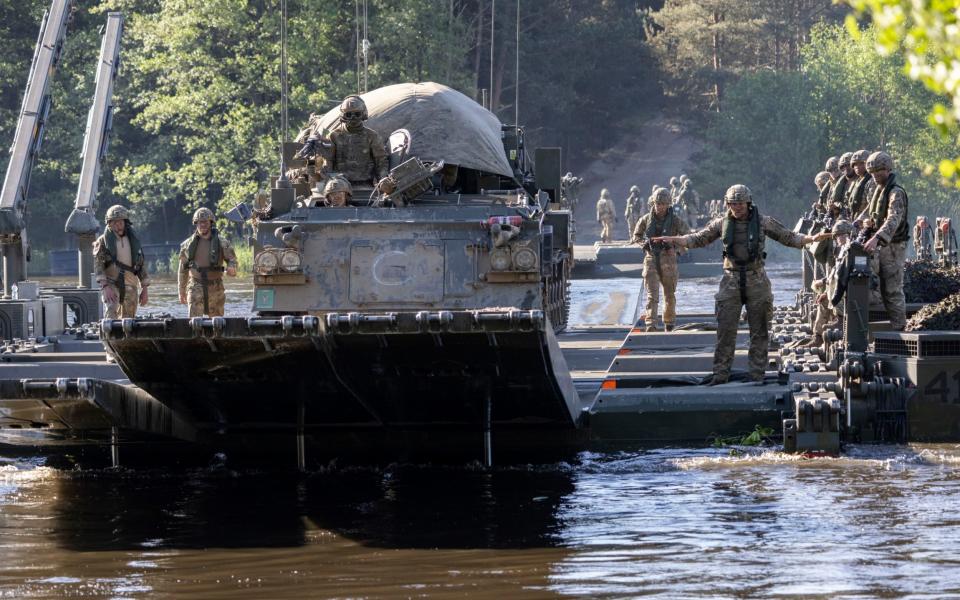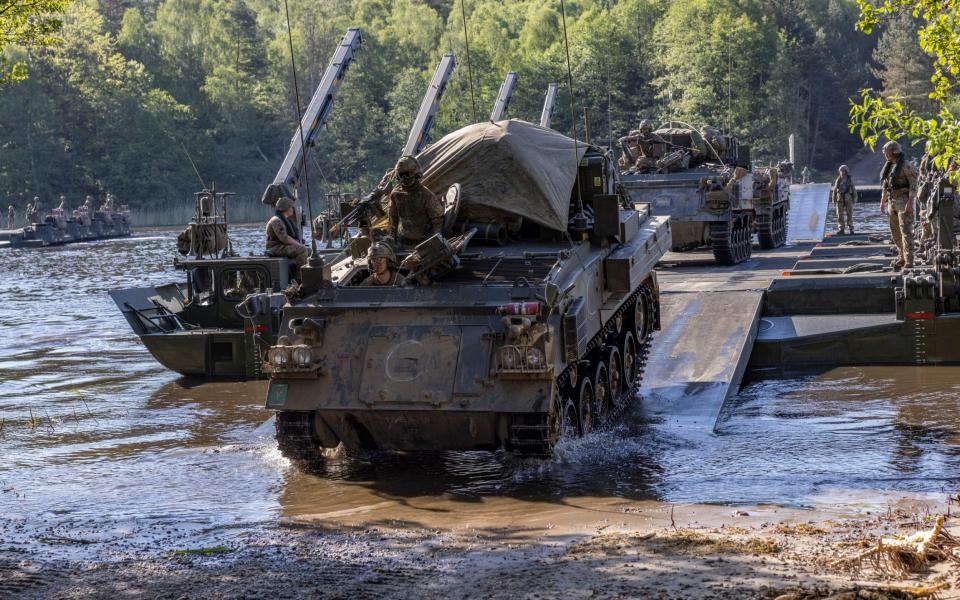Watch: British Army leaves US troops trailing in river crossing race
The 156-metre stretch across the Drawa River in western Poland would normally be a perilous scenario for approaching armies.
But on Friday, British engineers showed how to quickly overcome a daunting obstacle and get battle tanks across “troubled waters” in just 18 minutes.
Demonstrating skill and efficiency, they set up specially designed floating vehicles to open a crossing for military vehicles, leaving their American allies trailing behind, during a Nato exercise.
As US soldiers took an hour to assemble a regular ribbon bridge, British engineers raced ahead using the Army’s M3 amphibious rig, a 24.5-ton truck that folds out into a floating platform.
The vehicles, which have their own nicknames ranging from M-3PO, inspired by the Star Wars character C-3PO, to M3 Hammer, after the rapper, first entered service in the 1990s and have not been used in combat since the beginning of the Iraq war.
However, they have now become more strategically important than ever amid the backdrop of the war in Ukraine and the threat of Russia to Eastern Europe.
While Friday’s exercise in Poland was part of a major Nato war game, in neighbouring Ukraine, a similar crossing could prove fatal for both sides where lengthy attempts to cross the waters of the Donbas have left troops sitting ducks.
Near the small town of Drawsko Pomorskie, the first M3 appeared through the Polish woodland just before 6.40am as it approached the Jezioro Zly Leg crossing.

Appearing at first simply to be a large military vehicle, two pontoons folded out on either side within seconds doubling the width of the rig, to the delight of those watching.
“It’s like the flowers of a petal,” noted one soldier as it successfully unfolded before 11 others made their way through the path carved through the birch and pine trees and splashed into the water one by one.
Once the rig is “swimming”, the team of three on board immediately got to work putting its platforms into place with the assistance of a crane before they are linked together in threes to form ferries.
Within 18 minutes of the first M3 hitting the water, the first Land Rovers and Army trucks began to move across the river to secure the crossing, which would welcome 65-ton Challenger 2 tanks later in the day.
The US soldiers a few hundred metres upstream were still languishing behind linking the pontoons of their bridge, of which the sections were last used in combat in Vietnam, eventually opening after more than an hour.
Barring one armoured vehicle which struggled to board, the British ferries then rotated seamlessly taking one to two vehicles at a time and moving off, before another collected the latest batch of armoured machines. Each crossing once the vehicles were loaded took just 45 seconds.
Working at full speed, the set-up is capable of moving 200 vehicles per hour or sub unit of tanks in 20 minutes, and once their task is completed the M3s are capable of reaching 50mph back on land.

In front of Army chiefs, hundreds of vehicles crossed the rigs and two other crossings yesterday as the culmination of Exercise Immediate Response, part of the wider Steadfast Defender operation, a Nato war game and the largest deployment to Europe in 40 years.
The two-week exercise involving British, Polish and US armies included nearly 2,400 UK troops and 1,105 vehicles including 22 Challenger tanks, 88 Warrior infantry fighting vehicles and 104 Bulldog armoured personnel carriers.
‘I had a bet with the Americans’
Maj Ryan Ingram, the commanding officer of 23 Amphibious Engineer Squadron manning the M3s, said he’d had a “wager” with the Americans over who could establish a crossing quickest throughout the week.
“The maths never lies. It’s been a wager between me and my US peer with regards to which one is faster. So far, I’m winning and I haven’t lost a round this week,” he said before explaining the logistical advantages of the British approach.
“We can multiple stack on the ferries that allows us to put more over at a time because they are restricted by speed and they are also restricted by the fact vehicles can’t hard-brake or anything on the pontoons.
“I have full faith that the science and maths is there. As long as the crews do as they are instructed, it’s really quite safe.”
In a real-life war situation such as in Ukraine, crossings could come under attack with vehicles stuck on bridges becoming easy targets. However, using ferries allows for a quick escape.
‘We could just disappear’
“We’d break and hide,” he said. “If any fire came into play, we’d just break away and disappear into the river and to a safe location.”
There are more than 1,900 such river crossings in Northern Europe alone making the manoeuvre hugely important if Russia were to attack Nato allies.
“It’s more important than ever that we’ve got this kind of capability: speed and manoeuvrability on the battlefield.
“We want to be in, out and gone before we have even been seen.”
Referring to Russians coming under attack while trying to gain territory while crossing in Ukraine, he added: “If you are trying to cross a particularly difficult obstacle you want to be in and out the way before you are even seen. The Russians got it wrong. You can always learn from other people’s mistakes.”
This was the first Nato operation for Maj Ingram and his squadron since the Army lifted its ban on facial hair. Sporting a beard himself, he claimed it had made the regiment even more efficient.
“You’ve got to adapt, you’ve got to go with change. There is no harm in change,” he said.
“We’ve not had any problems and on an exercise it saves us no end of water with shaving. It’s one of those things we don’t have to worry about in the field.”

